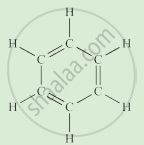Advertisements
Advertisements
प्रश्न
Explain the following:
Polar covalent compounds are good conductors of electricity.
उत्तर
Polar covalent compounds are good conductors of electricity because when these are dissolved in water, they ionize and act as electrolyte to produce ions which are responsible for conduction of electricity.
For example polar covalent compound HCl in water behaves as:
HCI + H2O → H3O+ + CI-
These hydronium and chloride ions produced on dissolution of HCl in water are responsible for conduction of electricity.
APPEARS IN
संबंधित प्रश्न
What are covalent compounds?
Name the type of bonds formed in ionic compounds and in the compounds formed by carbon.
Buckminsterfullerene is an allotropic form of the element:
(a) phoshorus
(b) fluorine
(c) carbon
(d) sulphur
One of the following is not an allotrope of carbon. This is:
(a) diamond
(b) graphite
(c) cumene
(d) buckministerfullerene
An element E exists in three allotropic forms A, B and C. In allotrope A, the atoms of element E are joined to form spherical molecules. In allotrope B, each atom of element E is surrounded by three other E atoms to form a sheet like structure. In allotrope C, each atom of element E is surrounded by four other E atoms to form a rigid structure.
(a) Name the element E.
(b) What is allotrope A.
(c) What is allotrope B?
(d) What is allotrope C?
(e) Which allotrope is used in making jewellery?
(f) Which allotrope is used in making anode of a dry cell?
What is the difference between ionic compounds and covalent compounds?
Draw an electron dot structure of the following molecule. (Without showing the circle) :
Water
Covalent bonds can be single, double or triple covalent bonds. How many electrons are shared in each? Give an example of each type.
Complete the following activity.
Write the names of the hydrocarbons for the following structural formula.
(isobutylene, cyclohexane, propene, cyclohexene, cyclopentane, benzene, propyne, isobutane, propane)
 |
Which of the following compounds of carbon does not consist of ions?
